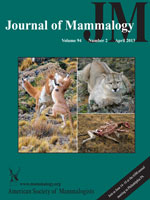Variation in space-use patterns among free-ranging mammal populations has been an important area of study in behavioral ecology. We investigated the influence of landscape characteristics associated with landscape fragmentation and diversity on the home-range size of white-tailed deer (Odocoileus virginianus). We evaluated the relative contribution of 3 main land-cover types (forest, agriculture, and rangeland) to the composition of each home range and constructed sex- and season-specific linear regression models using landscape metrics relevant to habitat fragmentation and diversity. Both core and home-range areas were dominated by forest, agriculture, and rangeland. We found that landscape configuration metrics aimed at quantifying landscape fragmentation were good predictors of space use by white-tailed deer and that deer occupied smaller home ranges in highly fragmented areas. Our results indicate that once important cover types are present and patches are sized to meet the resource needs of the individual, configuration of those resource patches influences overall space use. These findings support the assertion that space use by white-tailed deer varies along a gradient of fragmentation.
How to translate text using browser tools
1 April 2013
Landscape structure influences space use by white-tailed deer
Amy C. Dechen Quinn,
David M. Williams,
William F. Porter
ACCESS THE FULL ARTICLE

Journal of Mammalogy
Vol. 94 • No. 2
April 2013
Vol. 94 • No. 2
April 2013
composition
configuration
fragmentation
home range
landscape structure
Odocoileus virginianus
space use




